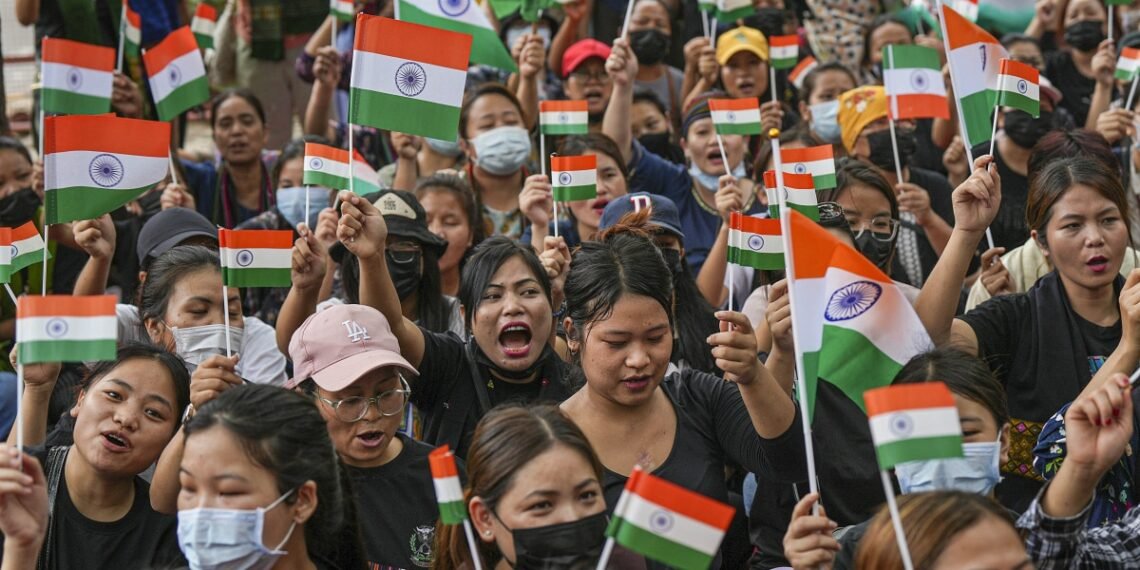With references to historical records from as early as 641 CE, the Young Kuki organization seeks to dismantle allegations that Kukis lack political and historical legitimacy, asserting that their struggle for recognition will not be silenced in 2025.
BY PC Bureau
The Young Kuki Organization has released a strongly worded rebuttal in response to an article published in Ukhrul Times, titled Behind the Veil: Kuki’s Controversial Identity and the Conflict That Persists, authored by Dirinamai Liangchi. The organization has condemned the article as “riddled with historical inaccuracies” and “a shameless attempt at propaganda.”
Allegations of Historical Distortion
In its official statement, Young Kuki labeled the article as “xenophobic, fascist, and racist drivel dressed up as ‘historical analysis.’” The organization accused Liangchi of pushing an “anti-Kuki agenda” promoted by external forces, including what it termed as “genocidal outfits like NSCN-IM.”
ALSO READ: Manipur Police: Mobile Phones as ‘Major’ Police Finds.
“The writer, likely some half-witted pawn of the Meitei supremacist establishment, has not even made an effort to verify his claims. He instead vomits out tired propaganda that has been manufactured to justify crimes against Kukis,” the statement read.
The organization challenged what it described as “baseless allegations” about the origins of the Kuki-Zo people, particularly the claim that Kukis were brought by the British as refugees and mercenaries. Citing historical records, it argued that the Kuki presence in the region predates British colonial rule by centuries.
𝐘𝐎𝐔𝐍𝐆 𝐊𝐔𝐊𝐈
𝐏𝐫𝐞𝐬𝐬 𝐑𝐞𝐥𝐞𝐚𝐬𝐞
𝟏𝟗𝐭𝐡 𝐅𝐞𝐛𝐫𝐮𝐚𝐫𝐲 𝟐𝟎𝟐𝟓𝐘𝐨𝐮𝐧𝐠 𝐊𝐮𝐤𝐢 𝐫𝐞𝐛𝐮𝐭𝐬 𝐝𝐞𝐥𝐢𝐛𝐞𝐫𝐚𝐭𝐞 𝐥𝐢𝐞𝐬 𝐚𝐧𝐝 𝐩𝐫𝐨𝐩𝐚𝐠𝐚𝐧𝐝𝐚 𝐚𝐠𝐚𝐢𝐧𝐬𝐭 𝐭𝐡𝐞 𝐊𝐮𝐤𝐢 𝐩𝐞𝐨𝐩𝐥𝐞. @ShekharGupta @Kashish__singh_ @afridahussai @meipat pic.twitter.com/ePTheAY75r
— Analytical Kuki (@Analytical_Kuki) February 19, 2025
“The claim that Kukis were ‘refugees brought by the British’ is a regurgitated lie that has been debunked countless times. The Kuki presence in the region is well-documented in sources like the Tripura copper plates (641 CE, 1194 CE), Tibetan historian Taranatha’s writings (1608), Cheitharol Kumbaba, Pemberton (1835), and McCulloch (1859),” the statement asserted.
ALSO READ: War of Words Erupts in Manipur After NSCN-IM Leader Calls Kukis “Refugees”
The statement went on to reference multiple historical documents to support its claims:
- Taranatha’s History of Buddhism in India (1608) refers to highland inhabitants between Bengal and Burma as Ko-ki, affirming the long association of Kukis in the region.
- Tripura copper plates (641 CE, 1194 CE) mention Kuki settlements, proving their presence over a millennium ago.
- Cheitharol Kumbaba records various Kuki tribes under different names—Khongjai, Khaki Haos, Khongchais, and Sairem—demonstrating a deep-rooted history in the region.
- Pemberton’s 1835 account establishes the Kuki ancestral land stretching from Manipur’s southern borders to the northern Arakan ranges, countering the claim that Kukis were late arrivals.
- McCulloch (1859) noted the Kukis had distinct socio-political structures and had long existed in the hills of Manipur before the British arrived.
Kuki Political Representation and Indigenous Status
Young Kuki also refuted claims that Kukis lacked political representation before the 1980s, providing evidence from past electoral victories:
“In the 1967 Manipur Territorial Legislative Assembly Elections, Kukis won five out of nine tribal seats. In the 1974 elections, Kukis won eight out of nineteen tribal seats. Similarly, in 1980, Kukis secured eight tribal constituencies, dispelling the myth that they were insignificant politically before the 1980s,” the statement outlined.
It also highlighted how Kuki populations in regions like Tamenglong, Ukhrul, and Senapati declined due to what it described as “systematic expulsion by NSCN-IM and their Meitei allies.”
The organization emphasized that Kukis have been recognized as Scheduled Tribes in India since 1950, asking, “If Kukis were refugees, why did the Government of India recognize them as an indigenous Scheduled Tribe from the very beginning?”
Rejection of ‘Manufactured History’ and Legal Action Warning
The Young Kuki Organization accused NSCN-IM and their allies of fabricating historical narratives to justify what it termed as “ethnic cleansing against Kukis.” It cited an instance where a document, the “Konsakhul Land Deed,” claimed to be from the 1920s, was allegedly written with a ballpoint pen—an invention that was not widely available at the time.
“This pathetic attempt to distort history will not go unanswered. The Kukis of the 1990s may have been silenced, but the Kukis of 2025 will not tolerate these insults and propaganda. Every fabricated document, every racist attack can and will be fact-checked, exposed, and dismantled in real-time,” the statement warned.
The organization declared its intent to take legal action against the Ukhrul Times writer, stating, “Young Kuki will proceed with legal actions against the writer for his deliberate spread of misinformation, incitement, and racist propaganda.”
Final Stand: ‘The Kuki People Will Not Be Silenced’
Reaffirming their resilience, Young Kuki asserted that their history, identity, and struggles will not be erased.
“The writer has been caught red-handed fabricating history. His entire article is nothing more than a Meitei-sponsored fairy tale. The Kuki people demand justice, not propaganda. And we will not be silenced.”
The statement concluded with the rallying cry: “Stand Firm, Stand United. Kuki Kahi Kakipah E.”













